
Aside from Japanese cuisine’s strong sense of culture and history and innovative flavors, the importance they put on the quality and seasonality of the ingredients used are very notable, too. From the meat, grains, herbs, spices, and yes especially the vegetables. There are many types of Japanese vegetables, and many ways to cook them that Westerners are not familiar with.
Japanese vegetables are very much a part and in fact a fundamental element of Japanese cooking.
A traditional Japanese diet is mainly fresh and unprocessed. Their food guide is illustrated with a spinning top. Its rotating inverted cone is divided from the top down with different food groups. And vegetable dishes are given importance next to grain dishes which makes the very top. They recommend about 5-6 servings of vegetables. See, they do love their veggies!
Aside from the food that they eat, the dietary guidelines that they follow pretty much make the Japanese diet so healthy. No wonder, they have the highest number of centenarians worldwide and a low (if not the lowest) obesity rate as well.
Part of their dietary guidelines, in addition to eating breakfast (yes, they’re big on breakfast, they’re not into skipping breakfast like most of us are), stress the importance of enjoying the natural bounty and change of seasons by using whatever local food or ingredients are available. This rings very true in how they use vegetables in their dishes. They always have the perfect dish for whatever vegetables are in season.
The vegetables used in Japanese cooking are not all natives to Japan, as many of these veggies are introduced to Japanese from mainland Asia and from Europe during the 16th century. Nonetheless even these vegetables have become a part of Japanese cuisine and become staples in many home kitchens and restaurants. If you want to learn more about Japanese cooking, perhaps these Japanese cookbooks will interest you.
Now, here is a list of different Japanese vegetables. Find out how many among these are already a part of your diet and which ones will likely pique your interest – because frankly, some of these veggies are very intriguing.
Types of Japanese Vegetables (With Pictures!)
Hakusai (Chinese cabbage)
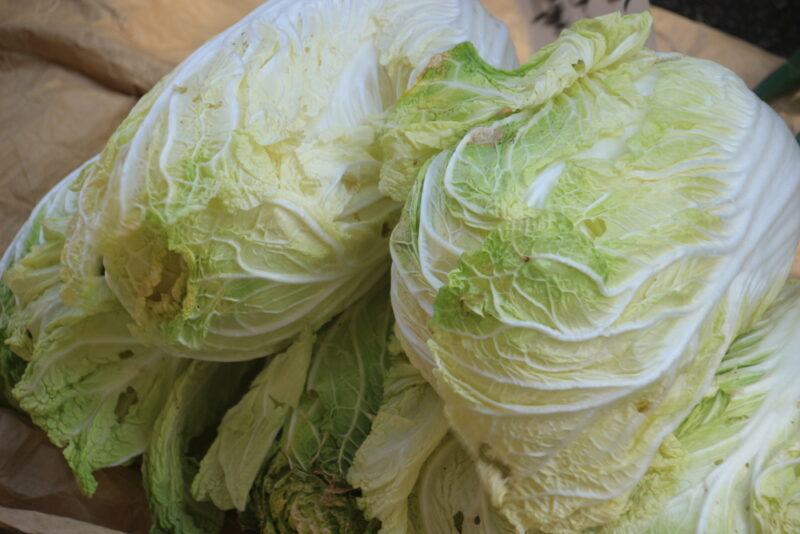
At the heart of Japanese winter comfort food, is the vegetable Hakusai or Chinese cabbage. It’s very versatile, in fact, it’s used in hot pots, fillings for dumplings, and in soups, just to name a few.
It’s an excellent source of folate and a great source of vitamin C. It also contains vitamin K, vitamin A, and other essential vitamins and minerals. This is on top of its many antioxidants plant compounds content.
Maitake Mushrooms (Hen-of-the-woods)

Maitake mushrooms are known in Japan as the ‘King of Mushrooms’ and are one of the most commonly consumed mushrooms there. It’s a great addition to soups. It can also be simply roasted, seared, or grilled. It has a deep, earthy, and savory flavor.
Maitake mushrooms are rich in antioxidants, beta-glucans, vitamins B and C, copper, potassium, minerals, amino acids, and fiber. It doesn’t hurt, too, that these mushrooms are low sodium, low calorie, fat-free, and cholesterol-free.
Horenso (Japanese spinach)

Horenso or the Japanese’ spinach is well-known in a dish called horenso no goma-ae. It’s made from blanched horenso mixed with sesame dressing. Commonly used as a side dish, horenso also makes for a great topping in soups.
In addition to horenso’s rich calcium and iron content, it also boasts vitamin A and vitamin C which can help support the immune system.
Shishito peppers (Japanese green pepper)

These small and mild peppers from Japan have a sweet and slightly smokey flavor. Shishito peppers are not really spicy, only 1 in 10 will be hot. It’s commonly served roasted or deep-fried like tempura.
Aside from its antioxidants content, shishito peppers are also a good source of vitamins A, C, and E.
Komatsuna (Japanese mustard spinach)

Komatsuna or Japanese mustard spinach has a tender and rich flavor with a mustard-like taste, hence the name. It is quite similar to spinach in terms of nutrient contents but lacks the hint of bitterness common to spinach.
It’s a great source of flavonoids, sulforaphane, indoles, carotene, lutein, and zeaxanthin. Komatsuna is rich in fiber, iron, and minerals and contains various types of vitamins as well.
Takenoko (Bamboo shoots)

Takenoko or bamboo shoots have a nutty and slightly sweet flavor. It is the soft top of the young bamboo plant. It can be grilled, steamed, deep-fried, or boiled. Takenooko makes a great addition to soups and stews.
Although it contains very few calories, it boasts high levels of fiber. Takenoko also contains a good amount of protein, copper, vitamin B6, and vitamin E.
Mizuna (Japanese mustard greens)

Mizuna is also known as Japanese mustard greens or spider mustard. It is a leafy green vegetable that’s native to East Asia. It comes in 16 varieties that vary in color and texture. Mizuna can be used in salads, soups, Japanese hot pots, or as garnishing to dishes.
Mizuna is low in calories but high in vitamins and minerals which include vitamin A, vitamin C, and vitamin K. It’s also rich in antioxidants that protect cells from damage. Mizuna also contains calcium and iron.
Gobo (Burdock root)

Gobo or burdock root is an edible root vegetable. It actually resembles a tree root but it softens when cooked. It has a mild but distinct flavor. It’s commonly added to soups and salads. It can be used in Nimono (boiled and seasoned vegetables).
Gobo is particularly rich in dietary fiber. It’s also high in calcium, potassium, and other minerals. It also contains a number of antioxidants like quercetin, phenolic acids, and luteolin.
Mitsuba (Japanese parsley)
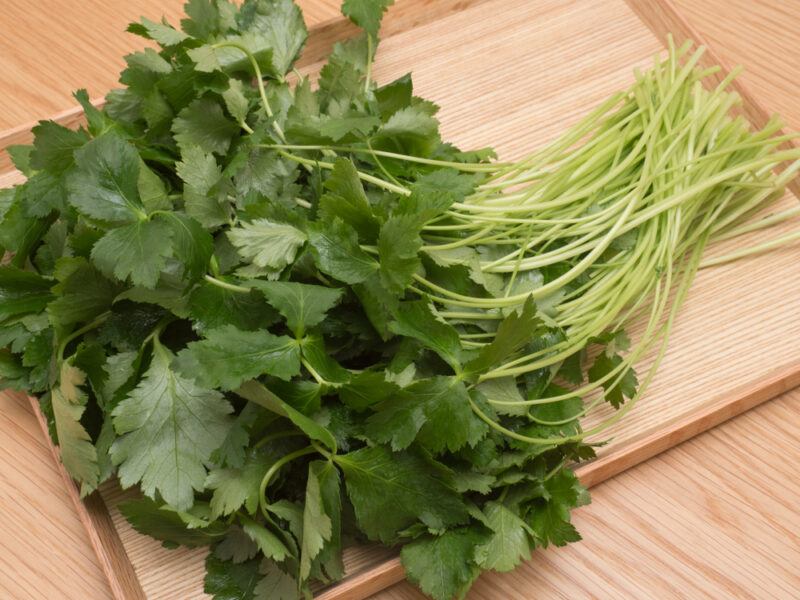
Mitsuba or Japanese parsley has a very distinct celery-like flavor with a hint of parsley taste. It even looks oddly similar to parsley with tender leaves and crunchy stalks. It’s used mainly in salads, soups, and as garnishing to sushi and sashimi.
Mitsuba is a great source of vitamin K and vitamin A. It also contains folate, vitamin C, biotin, and minerals like potassium, phosphorus, calcium, and magnesium.
Daikon (Giant white radish)
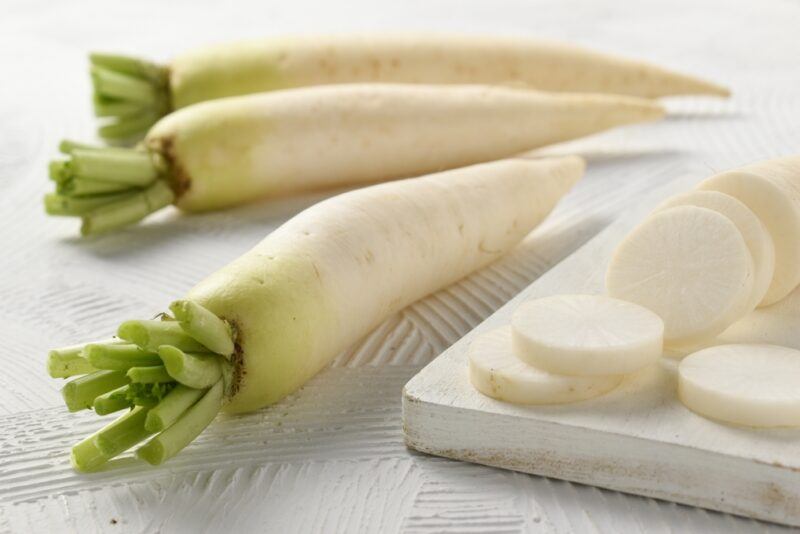
Daikon or giant white radish is definitely one of the most popular and versatile Japanese vegetables. It can be eaten both raw or cooked. Compared to other radishes, daikon has a milder flavor with a less peppery and slightly spicy taste. It turns slightly sweet with none of the spicy taste when it’s cooked.
Daikon is packed with vitamin C and many protective plant compounds. It’s also an excellent source of folate, calcium, magnesium, copper, and potassium.
Shiso (Perilla leaf)

Shiso or perilla leaf is one of the staple herbs in Japanese cooking. It’s known for its jagged leaves and refreshing flavor. The green shiso is often served with sashimi, in salads, or in soups. Red shiso on the other hand is used to add color to dishes and to pickle Japanese plum.
Shiso is rich in calcium, iron, and carotene (in fact it contains ten times more carotene than pumpkin). It also has anti-inflammatory, antiviral, antioxidant, and antibacterial properties.
Kabu (Tokyo turnip)

Kabu or sometimes called Tokyo turnip has a mild and fresh taste with notes of nuttiness, sweetness, and earthy flavor. These pastel white turnips shaped like a mini globe can be eaten raw or cooked. There are also kabu varieties that come with red skin which retains its deep rich color even after cooking.
Kabu is particularly rich in protein and calcium. It also contains vitamin C, iron, vitamin A, and fiber.
Negi (Japanese long onion)

Negi or Naga Negi which literally means long onion resembles leek (while smaller varieties of Negi resemble chives). Although they are used in the same way, Negi has a tough texture that can withstand long cooking periods. There are two common varieties, the Kanto (long white stem), and the Kansai (stem is almost entirely green).
Negi contains vitamin A, vitamin C, and vitamin K. It also has calcium, copper, iron, and vitamin B6.
Okura (Okra)

Okura or okra is a summer vegetable with a sticky or slimy texture when raw that lessens or disappears when boiled or fried. It can be eaten raw in salads, deep-fried n tempura, or simply serve with soya sauce and katsuobushi or smoked bonito flakes.
Aside from its antioxidants content, okra is also rich in vitamin A, vitamin C, and folate. It actually also contains a protein called lectin which may help in inhibiting cancer cell growth.
Goya (Bitter melon)

Goya, or bitter melon, is Okinawa’s superfood. This bumpy, cucumber-shaped vegetable contains a phytonutrient called polypeptide-P which helps in lowering blood sugar levels. It also has charantin which helps in increasing the metabolism of glucose in the body.
Goya is also a good source of fiber, vitamin C, folate, and vitamin A. It’s good for stimulating digestion, regulating bowel movements, aiding weight loss, and may also have cancer-fighting properties.
Satsuma-imo (Sweet potato)

Satsuma-imo or sweet potato is so popular in Japan that they even have satsuma-imo-flavored ice cream. It’s also featured in many desserts on top of the many dishes that you can make from it.
Satsuma-imo is rich in phytonutrients like coumarins, peonidin, chrysoeriol, quercetin, and kaempferol. It also contains phytosterols that may lower LDL cholesterol and polyphenols which work as antioxidants.
Wasabi root
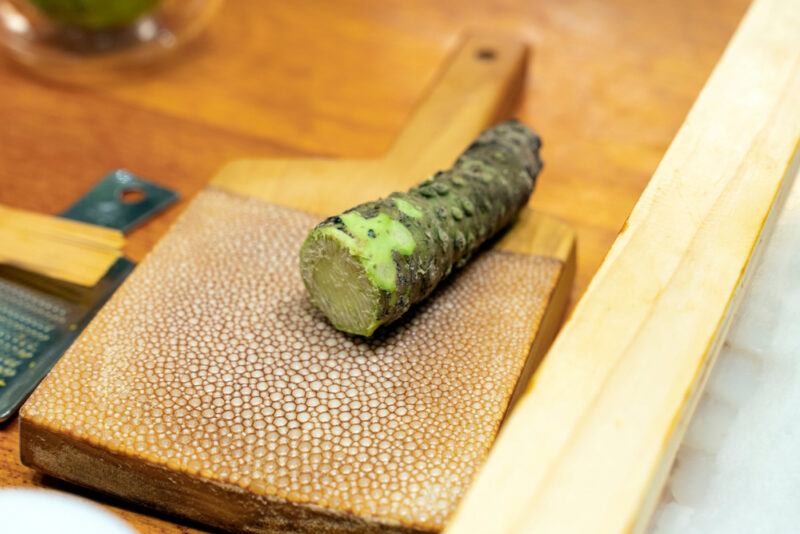
Wasabi root is the root of the wasabi plant that is grated (traditionally on a wooden board lined with rough shark skin) and used as a condiment. Although we’re more familiar with the green-colored paste with a burning hot taste, real wasabi has a sweeter, milder, and fruitier flavor.
Wasabi is particularly rich in beta carotene, isothiocyanates, and glucosinolates. It also contains naturally occurring compounds called ITCs which may have antibacterial and anti-inflammatory properties.
Kabocha (Japanese pumpkin)

Kabocha is a Japanese variety of winter squash. It has a flavor very similar to the pumpkin with a slightly sweeter taste. It’s traditionally eaten in the winter solstice celebrations. It can be made into tempura or kabocha purin (sweet pumpkin pudding).
Kabocha, in addition to its antioxidants content also contains vitamin A, vitamin C, B vitamins, magnesium, potassium, and fiber. The seeds are particularly good sources of protein, zinc, and healthy oils.
Nagaimo (Japanese mountain yam)

Nagaimo or Japanese mountain yam has a mellow taste and is the only yam that is edible in its raw form. It’s usually prepared by soaking it in acid then gets grated into a slimy paste that adds texture to noodles or rice.
It contains high levels of amylase that aids in the digestion of starchy foods. It also contains protein, minerals, and vitamin C. Its diastase content helps in promoting digestion and activating liver function.
Myoga (Japanese ginger)

Myoga or Japanese ginger belongs to the ginger family but unlike ginger where it’s the rhizomes that are used in cooking, with myoga, it’s the flower buds and the flavorful shoots that are edible. It does have a mild ginger-like taste with a crisp and crunchy texture. It’s commonly sliced finely and used as a condiment in soups, sashimi, cold noodles, sushi, salads, or pickles. It can also be sprinkled on top of roasted meats and vegetables.
Myoga contains vitamin K, folate, vitamin A, vitamin C, manganese, magnesium, potassium, calcium, copper, phosphorus, and molybdenum.




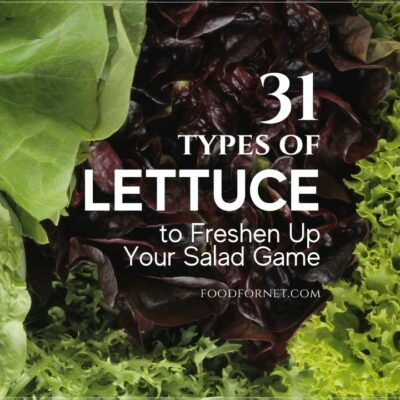












 22 Types of Foods Low in Copper Plus Tips to Remember When on a Low Copper Diet
22 Types of Foods Low in Copper Plus Tips to Remember When on a Low Copper Diet
Leave a Reply